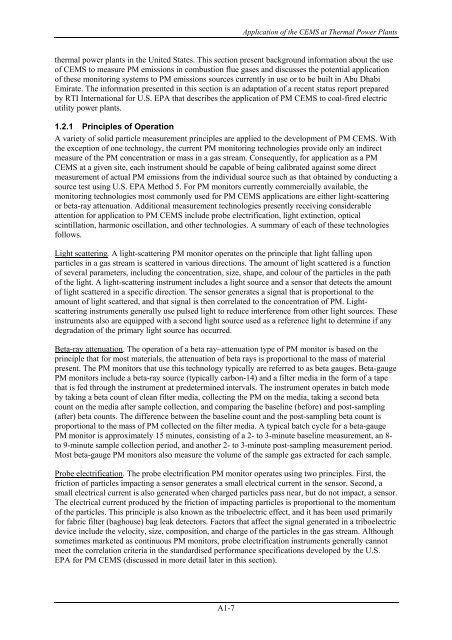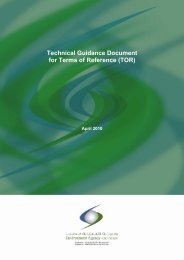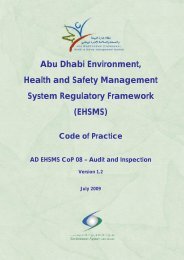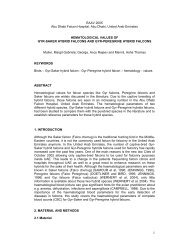Standard Operating Procedure (SOP) for Compliance Monitoring ...
Standard Operating Procedure (SOP) for Compliance Monitoring ...
Standard Operating Procedure (SOP) for Compliance Monitoring ...
You also want an ePaper? Increase the reach of your titles
YUMPU automatically turns print PDFs into web optimized ePapers that Google loves.
Application of the CEMS at Thermal Power Plants<br />
thermal power plants in the United States. This section present background in<strong>for</strong>mation about the use<br />
of CEMS to measure PM emissions in combustion flue gases and discusses the potential application<br />
of these monitoring systems to PM emissions sources currently in use or to be built in Abu Dhabi<br />
Emirate. The in<strong>for</strong>mation presented in this section is an adaptation of a recent status report prepared<br />
by RTI International <strong>for</strong> U.S. EPA that describes the application of PM CEMS to coal-fired electric<br />
utility power plants.<br />
1.2.1 Principles of Operation<br />
A variety of solid particle measurement principles are applied to the development of PM CEMS. With<br />
the exception of one technology, the current PM monitoring technologies provide only an indirect<br />
measure of the PM concentration or mass in a gas stream. Consequently, <strong>for</strong> application as a PM<br />
CEMS at a given site, each instrument should be capable of being calibrated against some direct<br />
measurement of actual PM emissions from the individual source such as that obtained by conducting a<br />
source test using U.S. EPA Method 5. For PM monitors currently commercially available, the<br />
monitoring technologies most commonly used <strong>for</strong> PM CEMS applications are either light-scattering<br />
or beta-ray attenuation. Additional measurement technologies presently receiving considerable<br />
attention <strong>for</strong> application to PM CEMS include probe electrification, light extinction, optical<br />
scintillation, harmonic oscillation, and other technologies. A summary of each of these technologies<br />
follows.<br />
Light scattering. A light-scattering PM monitor operates on the principle that light falling upon<br />
particles in a gas stream is scattered in various directions. The amount of light scattered is a function<br />
of several parameters, including the concentration, size, shape, and colour of the particles in the path<br />
of the light. A light-scattering instrument includes a light source and a sensor that detects the amount<br />
of light scattered in a specific direction. The sensor generates a signal that is proportional to the<br />
amount of light scattered, and that signal is then correlated to the concentration of PM. Lightscattering<br />
instruments generally use pulsed light to reduce interference from other light sources. These<br />
instruments also are equipped with a second light source used as a reference light to determine if any<br />
degradation of the primary light source has occurred.<br />
Beta-ray attenuation. The operation of a beta ray–attenuation type of PM monitor is based on the<br />
principle that <strong>for</strong> most materials, the attenuation of beta rays is proportional to the mass of material<br />
present. The PM monitors that use this technology typically are referred to as beta gauges. Beta-gauge<br />
PM monitors include a beta-ray source (typically carbon-14) and a filter media in the <strong>for</strong>m of a tape<br />
that is fed through the instrument at predetermined intervals. The instrument operates in batch mode<br />
by taking a beta count of clean filter media, collecting the PM on the media, taking a second beta<br />
count on the media after sample collection, and comparing the baseline (be<strong>for</strong>e) and post-sampling<br />
(after) beta counts. The difference between the baseline count and the post-sampling beta count is<br />
proportional to the mass of PM collected on the filter media. A typical batch cycle <strong>for</strong> a beta-gauge<br />
PM monitor is approximately 15 minutes, consisting of a 2- to 3-minute baseline measurement, an 8-<br />
to 9-minute sample collection period, and another 2- to 3-minute post-sampling measurement period.<br />
Most beta-gauge PM monitors also measure the volume of the sample gas extracted <strong>for</strong> each sample.<br />
Probe electrification. The probe electrification PM monitor operates using two principles. First, the<br />
friction of particles impacting a sensor generates a small electrical current in the sensor. Second, a<br />
small electrical current is also generated when charged particles pass near, but do not impact, a sensor.<br />
The electrical current produced by the friction of impacting particles is proportional to the momentum<br />
of the particles. This principle is also known as the triboelectric effect, and it has been used primarily<br />
<strong>for</strong> fabric filter (baghouse) bag leak detectors. Factors that affect the signal generated in a triboelectric<br />
device include the velocity, size, composition, and charge of the particles in the gas stream. Although<br />
sometimes marketed as continuous PM monitors, probe electrification instruments generally cannot<br />
meet the correlation criteria in the standardised per<strong>for</strong>mance specifications developed by the U.S.<br />
EPA <strong>for</strong> PM CEMS (discussed in more detail later in this section).<br />
A1-7

















